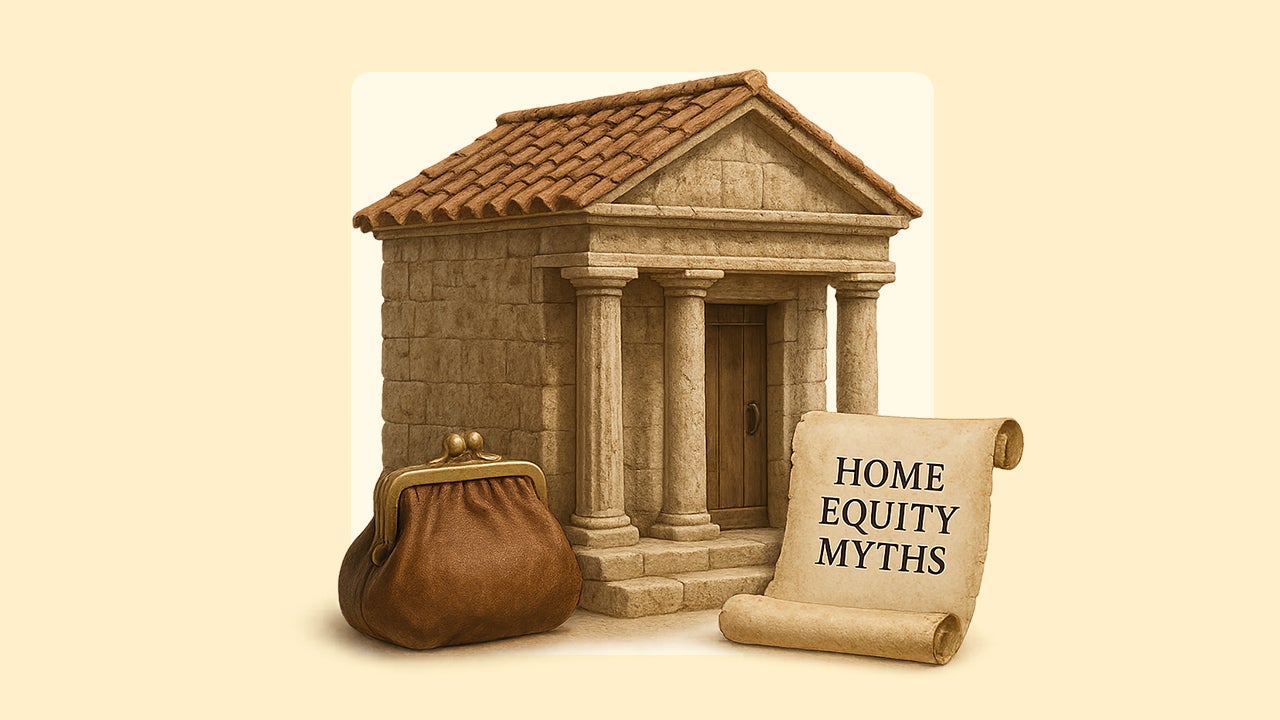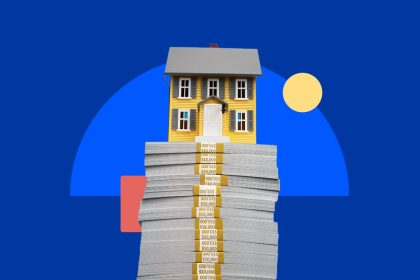Home equity sounds like a pretty straightforward concept: it’s the portion of your home you truly own, free and clear of debt. However, when it comes to understanding concepts like how home equity grows, the differences between home equity products, or how much equity you can borrow against – people can get a lot of things wrong.
As a Certified HELOC Specialist, I often field many questions from confused homeowners on everything about home equity, including what it is, how to tap into your home’s value, how that may impact your primary mortgage and more. A quick scroll through social media or online forums reveals a lot of misinformation out there. To help cut through the noise, I’m using this Bankrate column to dispel nine myths and misconceptions about home equity and home equity borrowing – revealing the truth that every homeowner needs to know.
1. Misconception: home equity = home value
Just because the value of your home is $500,000 doesn’t mean you have $500,000 in equity.
Home equity is based on your home’s worth, but it’s not the same thing. To figure out your home equity, you have to subtract your mortgage balance from the appraised value of your home. So, if your home is valued at $500,000, but you still owe $350,000, your equity stake is $150,000. Understanding this distinction is important, especially if you’re considering borrowing against your equity or selling your home.
2. Myth: Home equity always grows over time
Since the COVID pandemic, home prices and homeowner equity levels have soared to record highs. Some people assume that both will keep climbing — but as anyone who owned a home in 2008 can tell you, that’s not always the case. Residential real estate values declined drastically during the Great Recession. In fact, millions of homeowners found themselves in negative equity: owing more on their mortgages than their homes were worth.
Markets fluctuate and if home prices drop, so can your equity. Take what we’re seeing in 2025. The median home prices hit an all-time high of $422,800 in May 2025, and the average mortgage-holding homeowner has $302,000 in accumulated home equity as of the first quarter of this year, according to Cotality. But the pace of home price growth is slowing. And as home price appreciation slows, so do equity stakes. In fact, that $302,000 represents a loss of more than $4,000 in equity over the past year.
3. Myth: It takes years to build equity in your home
Not always. True, when you take out a mortgage, your home equity builds slowly at first as the early payments mostly cover your loan’s interest. As time passes, a greater portion of the payment goes to principal, speeding up equity growth. This process is known as mortgage amortization.
But not all paths to home equity growth involve the long game of paying down your mortgage. You can gain immediate equity by making a larger down payment or paying closing costs upfront instead of rolling them into the mortgage when you buy a home.
Additionally, making extra payments towards your loan’s principal can help you increase your housing stake faster. Home renovations can also boost your property value and, in turn, your equity. But remember, not all renovations offer the same return on investment (ROI). Some improvements, like kitchen or bathroom upgrades, tend to have a higher ROI than others.
4. Misconception: HELOCs and home equity loans are the same
I’ve often heard the terms HELOCs (home equity lines of credit) and home equity loans used interchangeably when describing home equity borrowing. Yes, both are financing products that allow you to borrow against your home’s value. Both also use your home as collateral, meaning you could lose it if you don’t make payments on either of them. That’s where most of the similarities end.
A home equity loan gives you a lump sum at a fixed rate, keeping your payments stable for the life of the loan. In contrast, a HELOC is a revolving line of credit with a variable rate, meaning your monthly payments may fluctuate based on the amount you borrow and market conditions.
The other differences? With a home equity loan, the interest is applied to the entire loan amount, but with a HELOC, interest is only charged on withdrawn funds. Mixing up the two and not fully understanding the differences can lead to some expensive surprises down the road.
5. Misconception: Home equity financing is always cheap
It’s true that home equity loans and HELOCs often come with lower rates than personal loans or credit cards. But we must not confuse “lower” with “low.” In today’s higher interest rate environment, they’re not always the deal they once were. For example, as of July 2, HELOC rates were averaging just over 8.25 percent, and some ran as high as 12.50 percent, according to Bankrate’s national survey of lenders. Home equity loan rates were similar, running as high as 10.47 percent.
The exact rate you are offered depends on several factors, including the lender, the loan type, your credit score and even where you live. Some advertised rates also include discounts if you sign up for automatic payments or have a checking account with that lender.
6. Myth: Tapping home equity will impact your primary mortgage
No matter what some TikTok influencers are saying, a HELOC is NOT like refinancing your mortgage.
HELOCs and home equity loans are considered second mortgages, which means they’re completely separate debt from your primary mortgage. Everything connected with that stays untouched, including its interest rate.
The confusion may arise from another equity-tapping vehicle, the cash-out refinance. This refi involves replacing your original mortgage with a bigger one; you take the difference — which is based on your equity stake — as a cash payout. That means you start fresh with a new mortgage, rate and terms.
7. Myth: Missing payments can’t trigger foreclosure
Even if they miss HELOC or home equity loan payments, some homeowners assume that as long as they’re paying their primary mortgage, their home is safe from foreclosure. They couldn’t be more wrong.
While HELOCs and home equity loans are second mortgages, they are still secured by your home. Regardless of whether your first mortgage is in good standing, the home equity lender has the right to start foreclosure proceedings if you are in default, which is 90 to 120 days of missed payments.
In the event of a foreclosure, your primary lender does get paid first. But that doesn’t stop the second lender from trying to recoup its share. Both lenders have a legal claim to your home, and if you’re in default on the second mortgage, it can trigger a foreclosure that puts your home at risk.
8. Misconception: You can access all your home equity
Just because you have a large percentage of equity in your home, doesn’t mean you can borrow all of it. Most lenders won’t let you go above 80 to 85 percent of your home’s value when borrowing, also referred to as the loan-to-value (LTV) ratio. Put another way: You have to leave 15 to 20 percent of your ownership stake untouched. Limiting the amount you can borrow provides a cushion that protects both you and the lender if your home falls in value.
How much equity you can borrow also depends on your mortgage balance. When computing that LTV, home equity lenders look at both the amount you want to borrow and your current mortgage debt. So if the LTV limit is 80 percent, and your mortgage balance makes up 50 percent of your home’s value, you’ll only be able to borrow 30 percent of the value, regardless of how much equity you have.
That said, there are some lenders that allow you to borrow 90, 95 or even 100 percent of the equity in your home. But there’s usually a trade-off: you will likely be charged a higher rate. You also have to meet certain requirements, like having a very strong credit score, a strong loan-to-value ratio, or borrowing within a specific loan amount range.
The bottom line: While hundreds of thousands of dollars in equity might look like a big number on paper, it’s not real cash in your pocket. Nor will all of it ever be. Even if you own your home entirely, usually you’ll be required to leave around one-fifth of your equity untapped.
9. Myth: Reverse mortgages are only for 62 year-olds and up
A reverse mortgage is a loan that allows you to borrow against your home equity. But instead of you having to pay the bank, the bank pays you (hence, the name). Whether taken in installments or as a lump sum, the funds are tax-free (though not interest-free).
It is true that you must be at least 62 years old to qualify for a Home Equity Conversion Mortgage (HECM), the most popular type of reverse mortgage, which is backed by the Federal Housing Administration. However, a HECM isn’t the only option.
Proprietary reverse mortgages are available for homeowners 55 and older. Offered by private lenders, these mortgages are not insured by the government. They are sometimes referred to as jumbo reverse mortgages because they allow homeowners to access larger amounts than the HECM limit, which is $1,209,750 in 2025.
Designed for higher-valued homes, loans are typically available in amounts up to $4 million, though you have to meet specific home equity, income and credit score requirements.
Separating home equity myth from reality
A home and its equity is the biggest asset many people will ever own. So it’s important to understand how your equity works and how you can – and can’t — use it. With all the confusing jargon, hard-sell ads, and questionable advice on social media, it’s easy to get steered in the wrong direction. Always consult a professional financial advisor or lender before making any moves: They’ll help you distinguish home equity fact from fiction.
Why we ask for feedback
Your feedback helps us improve our content and services. It takes less than a minute to
complete.
Your responses are anonymous and will only be used for improving our website.
Help us improve our content
Read the full article here
















